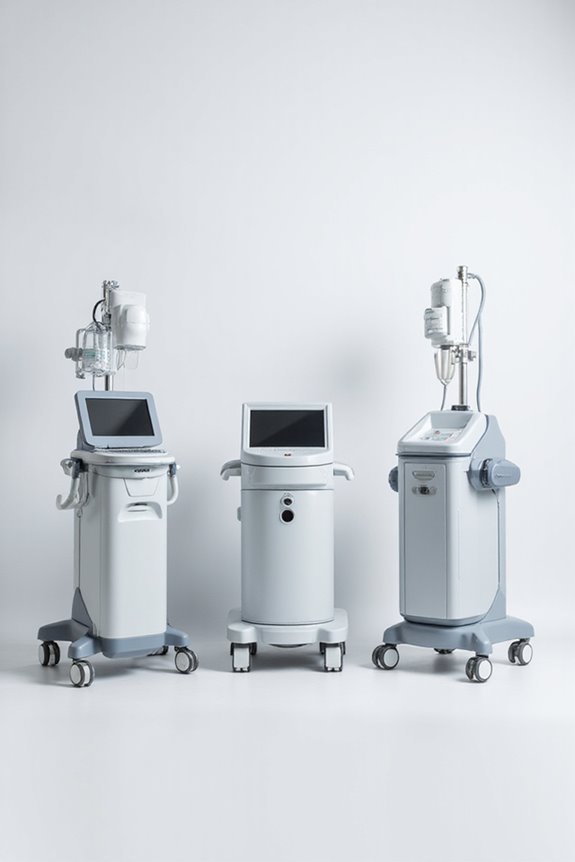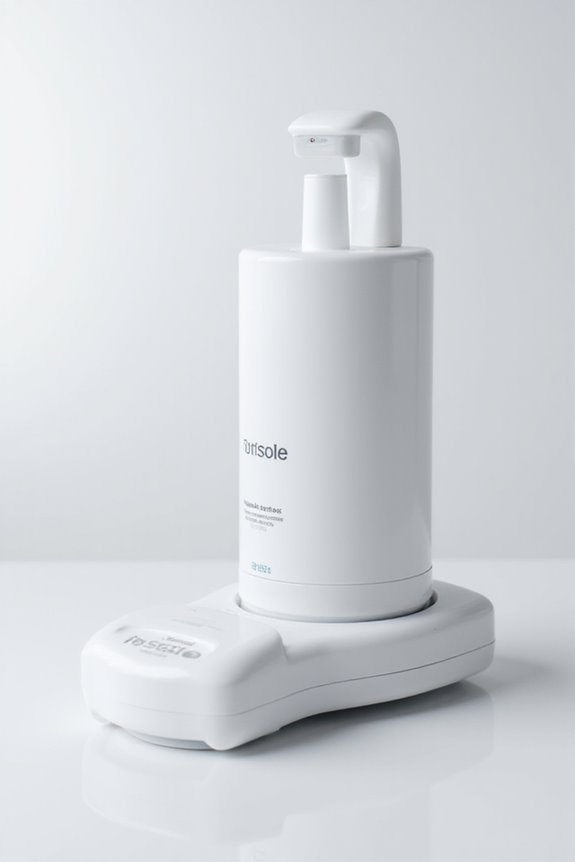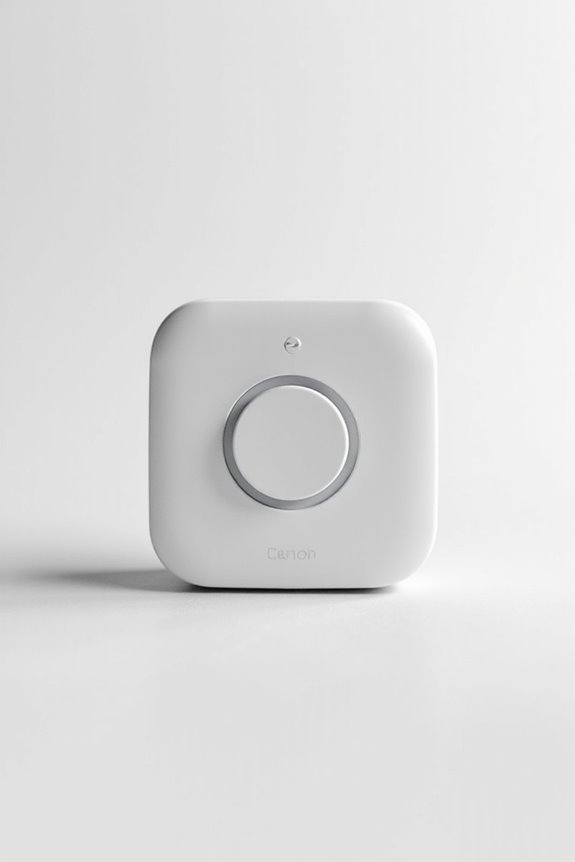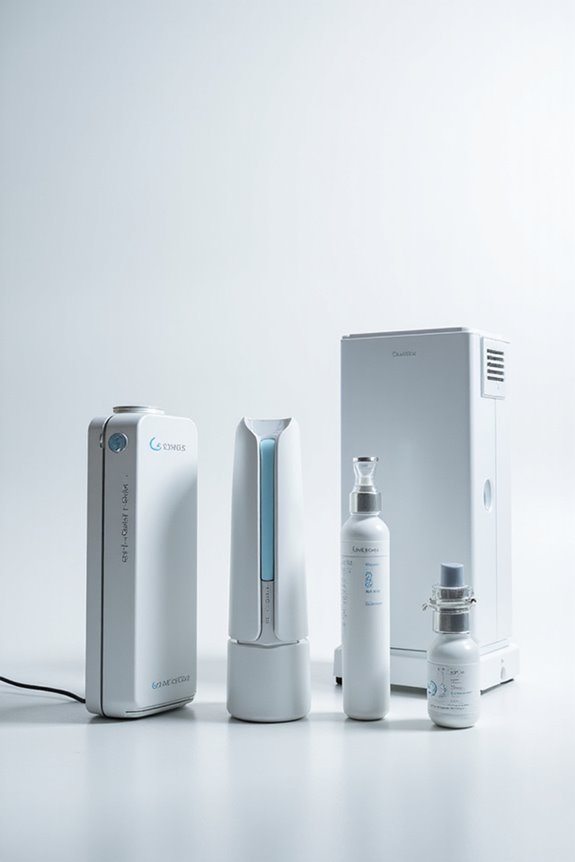Links below are affiliate links. We earn a commission on purchases at no extra cost to you. Although our opinions are based on curated research, we haven't used these products. Articles generated with AI. This article is for informational purposes only and does not constitute medical advice. Please consult a qualified professional for health-related questions.
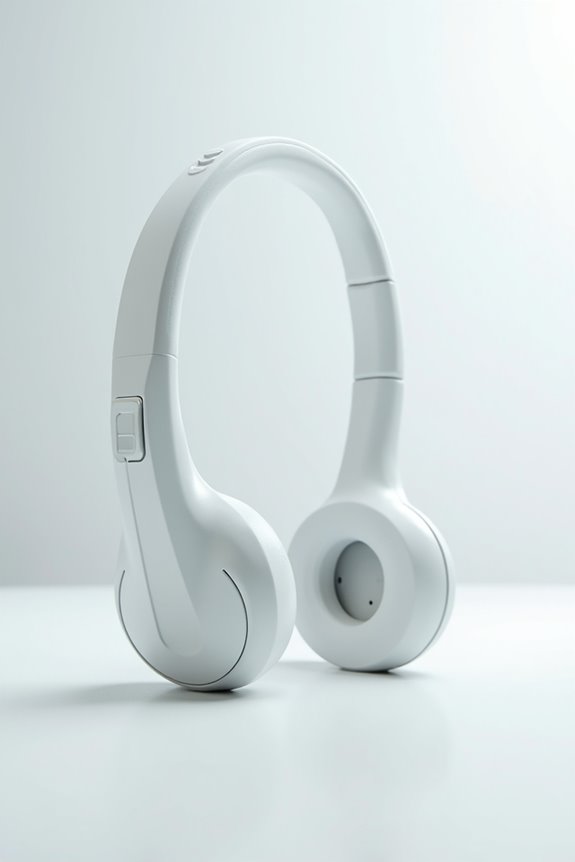
7 Best Assistive Listening Devices of 2025 – Enhance Your Hearing Experience
In 2025, the top assistive listening devices include:
- Neosonic Rechargeable Hearing Amplifier: Offers 50 hours of battery life, perfect for TV and conversations.
- Williams Sound Pocketalker 2.0: Amplifies sounds up to 40dB with user-friendly features for extended use.
- Rechargeable Hearing Aids with Bluetooth: Automatically pairs after charging for convenience.
- SuperEar Model SE5000: Provides 50dB amplification with disposable earpads for hygiene.
Explore features and considerations to enhance your auditory experience further.
Key Takeaways
- The Neosonic Rechargeable Hearing Amplifier offers excellent sound enhancement for TV watching and conversations with a comfortable, long-lasting neckband design.
- Williams Sound Pocketalker 2.0 provides robust amplification up to 40dB with customizable volume and tone controls for tailored sound experiences.
- Rechargeable Wireless Neckband Hearing Aids feature noise canceling and dual modes, making them suitable for various environments for seniors with mild to moderate hearing loss.
- The Reizen Loud Ear delivers powerful 120dB gain amplification with a built-in microphone for capturing sound from a distance in noisy settings.
- Price considerations range from basic models under $50 to advanced hearing aids over $7,000, emphasizing the need for value assessment against user needs.
Neosonic Rechargeable Hearing Amplifier and Wireless Neckband Headphones
Neosonic Rechargeable Hearing Amplifier to Aid TV Watching and Conversation, Wireless Neckband...
- BACKGROUND NOISE REDUCTION - Equipped with a wireless remote microphone, the NW10 Pro allows you to place the microphone close to the talker (up to 20 yards away). This...
- VERSATILE USE - Ideal for One-on-One Conversations, Group Meetings, and Television Listening. Features both a built-in microphone and a remote microphone, making it...
- RECHARGEABLE DESIGN - Both the amplifier and the microphone are rechargeable, eliminating the need to buy and replace batteries. The neckband amplifier provides up to 50...
Neosonic Rechargeable Hearing Amplifier and Wireless Neckband Headphones****
The Neosonic Rechargeable Hearing Amplifier and Wireless Neckband Headphones (NW10 Pro) cater specifically to seniors and adults seeking enhanced hearing capabilities for everyday activities.
- Designed for ideal sound in TV watching and conversations.
- Wireless neckband headphones provide comfort during prolonged use.
- Features include:
- Wireless remote microphone for background noise reduction, effective up to 20 yards.
- Built-in microphone for versatile applications, including meetings.
- Rechargeable battery lasts 50 hours for the amplifier and 10 hours for the remote microphone.
This device is suitable for both home and outdoor settings, addressing diverse user needs efficiently.
Best For: The Neosonic Rechargeable Hearing Amplifier and Wireless Neckband Headphones are best for seniors and adults seeking enhanced hearing during conversations and while watching television.
Pros:
- Comfortable neckband design allows for extended wear without ear fatigue.
- Wireless remote microphone effectively reduces background noise and improves audio clarity from a distance.
- Long-lasting rechargeable battery provides 50 hours of use for the amplifier, making it reliable for daily activities.
Cons:
- Some users report difficulties with volume control and remote microphone battery life.
- Earbud design may not provide stability during movement, impacting usability for active users.
- Mixed reviews on product longevity suggest reliability issues, with some devices failing to hold a charge over time.
Rechargeable Wireless Neckband Hearing Aids for Seniors and Adults
Sale
CESLIFF Rechargeable Hearing Aids, Wireless Neckband Amplifier for Seniors and Adults Noise...
- REDUCE BACKGROUND NOISE & NO FEEDBACK WITH 2 HEARING MODES: - Neckband hearing aids use upgraded chips to enhance human voice and reduce background noise. No whistling...
- RECHARGEABLE AMPLIFIER - Hearing aids are rechargeable, which means you don't need to buy and replace batteries. One charge can be used for 80H, no need to charge it...
- COMFORTABLE NECKBAND DESIGN - The neckband style effectively relieves the burden on your ears and provides a comfortable wearing experience. IPX4 waterproof and...
Rechargeable wireless neckband hearing aids are an excellent choice for seniors and adults experiencing mild to moderate hearing loss, particularly those who prioritize convenience and comfort.
Key Features
- Noise Canceling: Eliminates whistling.
- Dual Modes: Indoor and outdoor settings for various environments.
- Customization: Comes with three sizes of ear tips for a secure fit.
Design
- Neckband Comfort: Lightweight and IPX4 waterproof.
- User-Friendly: One-button power and five adjustable volume levels.
Limitations
- Not suitable for severe hearing loss.
- Mixed user feedback on noise performance and support.
At approximately $50, they offer an affordable temporary solution for those needing assistance with hearing.
Best For: Seniors and adults with mild to moderate hearing loss looking for a convenient and comfortable listening solution.
Pros:
- Noise Canceling feature eliminates whistling sounds for a more pleasant listening experience.
- Dual modes for both indoor and outdoor settings enhance versatility in various environments.
- Lightweight neckband design provides comfort and includes customizable ear tips for a secure fit.
Cons:
- Not suitable for individuals with severe hearing loss, limiting its usability for some users.
- Mixed feedback on noise filtering performance can lead to dissatisfaction in loud environments.
- Lack of customer support and difficulty in understanding instructions can be frustrating for users.
Williams Sound Pocketalker 2.0 Hearing Amplifier
Williams Sound Pocketalker 2.0 Hearing Amplifier | Easy-to-Use Hearing Amplifier for Seniors |...
- AMPLIFIES SOUNDS UP TO 40DB: Pocketalker 2.0 amplifies the sounds & voices around you that you actually want to hear, while reducing the sounds you don't. Adjustable...
- SIMPLE, USER-FRIENDLY DESIGN. Pocketalker 2.0 was designed to be set up & used in less than a minute. Simply insert the included batteries, plug in the microphone & your...
- LONG LASTING. Just (2) AAA alkaline batteries power the Pocketalker for up to 100 hours of typical usage. The Pocketalker also has the ability to use & charge...
For seniors and individuals with hearing impairments, the Williams Sound Pocketalker 2.0 Hearing Amplifier serves as an accessible and practical assistive listening device.
Key Features:
- Amplification: Boosts sounds up to 40dB, enhancing voices while minimizing background noise.
- User-friendly Design: Set up in under a minute, comes with batteries, and offers options for earbuds or headphones.
- Custom Controls: Includes adjustable volume and tone settings tailored to your needs.
- Durable Power Source: Operates on 2 AAA batteries for up to 100 hours, compatible with rechargeable options.
Warranty:
– Industry-Leading: Backed by a 5-year warranty, ensuring reliability.
While it’s effective, it isn’t a substitute for hearing aids.
Best For: Seniors and individuals with hearing impairments seeking an effective and affordable assistive listening device.
Pros:
- Amplifies sounds up to 40dB for improved communication in various settings.
- User-friendly setup that can be completed in under a minute with included batteries.
- Long battery life of up to 100 hours with AAA batteries, offering flexibility with rechargeable options.
Cons:
- Not a replacement for high-quality hearing aids, limiting its effectiveness in some cases.
- Durability concerns noted by some users, particularly with microphones and headphones.
- Compatibility issues with certain accessories and suggestions for improved comfort have been reported.
SuperEar Model SE5000 Personal Sound Amplifier for Seniors
SuperEar Model SE5000 (PSAP) for Seniors - Hearing Amplifiers for Seniors, Super Ear Personal Sound...
- COMPATIBILITY: Response to sound amplification is completely dependent on an individual's unique ability to detect sounds. For this reason, a PSAP may or may not work for...
- COMPLETE AMPLIFICATION SYSTEM: Get the ultimate sound experience with our complete amplification system! This package includes a powerful sound amplifier, HEADPHONES,...
- COMFORTABLE AND EASY TO USE SOUND AMPLIFIER: Our SuperEar Personal Sound Amplifier is like reading glasses for your ears, it is comfortable and very easy to use. The...
The SuperEar Model SE5000 Personal Sound Amplifier serves as an ideal solution for seniors experiencing hearing difficulties.
Key Features:
- Amplifies sound by up to 50 decibels, achieving a total gain of 107 dB.
- Includes headphones, earbuds, AAA battery, and a belt clip.
- Compatible with disposable earpad covers, enhancing hygiene.
User Benefits:
- Described as “reading glasses for your ears,” making it user-friendly.
- Reports indicate significant improvements in communication, especially in various environments.
Affordability:
– Priced around $65, offering a cost-effective alternative to traditional hearing aids, which can exceed $7,000.
This device enhances the hearing experience while remaining accessible and practical for seniors.
Best For: Seniors experiencing hearing difficulties who are looking for a cost-effective and user-friendly sound amplification solution.
Pros:
- Affordable price of around $65 compared to traditional hearing aids.
- Easy to use with no complex setup or charging required.
- Enhanced communication in various environments, improving quality of life.
Cons:
- Some users report minor static when moving the amplifier.
- Sound quality may vary when using the included headphones versus personal headphones.
- Not a substitute for professional hearing aids for individuals with profound hearing loss.
Elite Package: Reizen Loud Ear 120dB Gain Personal Amplifier
Elite Package: Reizen Loud Ear 120dB Gain Personal Amplifier
- Powerful personal amplifier with 120dB gain
- Built in microphone for clear and loud hearing
- Voice and sound comes through mini earphone
The Reizen Loud Ear 120dB Gain Personal Amplifier is particularly suited for seniors experiencing hearing challenges.
Key Features:
- 120dB gain for powerful amplification.
- Built-in microphone captures sound from 100 feet away.
- Transmits audio through included mini earphone.
User Feedback:
- Effective for conversations and TV viewing.
- Suitable for doctor appointments with elderly users.
Design Issues:
- Small volume dial can be turned too loudly inadvertently.
- On/off switch and battery compartment are difficult to operate.
Audio Quality:
- Included headphones may provide subpar sound.
- Users recommend better audio equipment for improved clarity.
Best For: Seniors experiencing hearing difficulties who need assistance in conversations and media consumption.
Pros:
- Effective amplification with a 120dB gain, making it suitable for important conversations and TV watching.
- Lightweight and portable, ideal for use in various settings such as home or during doctor appointments.
- Built-in microphone captures sound from a significant distance of up to 100 feet.
Cons:
- Volume control dial can be prone to accidental adjustments, making it potentially uncomfortable to use.
- On/off switch and battery compartment are not user-friendly, posing challenges for seniors with dexterity issues.
- Included headphones are of low quality, and sound may appear tinny with unwanted background noise.
Rechargeable Hearing Aids with Bluetooth for Seniors
Hearing Aids for Seniors, Rechargeable Hearing Aids with Bluetooth, Hearing Amplifier for the...
- Easy to Use: Our hearing aids feature a 2-in-1 design with built-in Bluetooth functionality, making it easy to listen to what's around you. Simply take the hearing aids...
- One-Touch Switching: Long press and hold the left or right earbud for 3 seconds to switch between hearing aid mode and Bluetooth mode. In Bluetooth mode, you can adjust...
- Quick Charging: Our rechargeable hearing aids offer up to 8 hours of battery life on a single charge in hearing aid mode. There's no need to replace batteries. The...
Rechargeable hearing aids with Bluetooth capabilities are ideal for seniors seeking a modern solution for auditory assistance. Here’s what you need to know:
Product Features:
- Automatically powers on and pairs after removal from the charging case.
- One-Touch Switching allows for easy mode changes.
- Bluetooth functionality enables volume adjustments, media control, and call handling.
- Quick charging: 8 hours of battery life in 60 minutes.
Design and Comfort:
- Stylish, resembling regular Bluetooth earbuds.
- Soft silicone tips guarantee comfort; lightweight design reduces ear pressure.
Feedback:
- Users report positive experiences with comfort and Bluetooth usability.
- Some note sound quality issues.
These devices offer an accessible alternative for basic hearing needs.
Best For: Seniors seeking an affordable, modern alternative to traditional hearing aids for casual use and basic auditory assistance.
Pros:
- Stylish design that resembles regular Bluetooth earbuds, appealing to younger users.
- Easy to use with features like one-touch switching and Bluetooth capabilities for volume and media control.
- Comfortable fit with soft silicone ear tips and lightweight design minimizing ear pressure.
Cons:
- Mixed reviews on sound quality, with some users experiencing static and difficulty with noise cancellation.
- Potential pairing issues with Bluetooth and performance limitations in noisy environments.
- May not meet all needs for serious hearing loss, as traditional hearing aids could perform better.
Peavey Assisted Listening Sys. 75.9 MHz
Peavey Assisted Listening Sys. 75.9 MHz
- Peavey Assisted Listening system includes transmitter, four receivers and four standard ear buds
- Additional receivers available
- Three frequency options
Designed to enhance auditory experiences, the Peavey Assisted Listening System operating at 75.9 MHz is particularly beneficial for elderly users facing hearing impairments.
- Components: The system includes a transmitter, four receivers, and four standard earbuds, with additional receivers available.
- Usability: It’s a plug-and-play setup requiring AA batteries and a simple connection via a guitar cable.
- User Feedback: Users report improved sound clarity and significant benefits during services, with some hearing for the first time in years.
Best For: The Peavey Assisted Listening System is best for elderly users with hearing impairments looking to enhance their auditory experience during services.
Pros:
- Easy plug-and-play setup with straightforward connectivity.
- Significant sound clarity improvement for users, especially beneficial for those with hearing challenges.
- Effective range of up to 100 feet, making it suitable for various settings such as churches.
Cons:
- Compatibility issues with stereo headphones and Bluetooth hearing aids, limiting user options.
- Some units may arrive dead or malfunctioning, causing potential frustration.
- Occasional reports of static noise and microphonics affecting audio quality.
Factors to Consider When Choosing an Assistive Listening Device
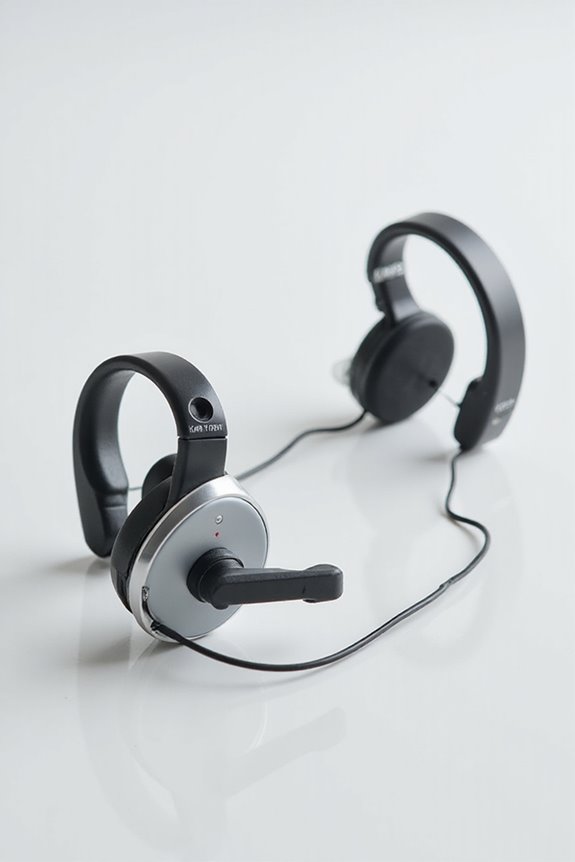
When choosing an assistive listening device, several key factors must be considered to guarantee it meets your specific needs. You’ll want to evaluate your type of hearing loss, the environments in which you’ll use the device, and the importance of sound clarity features. Additionally, comfort and fit, along with battery life, play vital roles in your overall satisfaction and usability of the device.
Type of Hearing Loss
Understanding the type of hearing loss is essential when selecting an appropriate assistive listening device. Hearing loss is classified into three categories:
- Conductive Hearing Loss: Often caused by obstructions or damage in the outer or middle ear. Devices that amplify sound frequencies work best here.
- Sensorineural Hearing Loss: Results from damage to the inner ear or auditory nerve. Devices need to deliver clearer sound quality and include noise reduction features.
- Mixed Hearing Loss: Combines aspects of both conductive and sensorineural types, requiring a versatile device that accommodates various amplification needs.
Consider the degree of hearing loss, measured in decibels (dB). Devices for mild to moderate loss (30-50 dB) differ considerably from those for severe loss (over 70 dB).
Environmental Settings
Environmental settings play an essential role in determining the effectiveness of assistive listening devices. Here are key factors to take into account:
- Typical Environment: Identify where you’ll use the device—noisy public spaces or quiet homes may require different solutions.
- Background Noise Levels: Devices with noise cancellation features are advantageous in crowded environments.
- Purpose of Use: Assess if you’ll use the device for one-on-one conversations, group settings, or media listening, as individual devices cater to specific scenarios.
- Range and Connectivity: Reflect on connectivity options, especially in larger spaces where distance affects sound quality.
- Comfort and Usability: Prioritize ease of use and comfort, particularly for seniors who need straightforward operation.
These factors can greatly influence your overall listening experience.
Sound Clarity Features
Selecting an assistive listening device that optimizes sound clarity is essential for enhancing your auditory experience. Here are key features to take into account:
- Adjustable Volume and Tone Control: Customize your auditory experience to various environments and personal preferences.
- Noise-Canceling Technology: This feature minimizes background noise, improving clarity of voices and important sounds during conversations and television watching.
- Sound Amplification: Devices can amplify sound up to 120 dB, effectively increasing your ability to hear.
- Built-in Microphones: These capture audio from a distance while reducing ambient noise, leading to more intelligible conversations.
Ensuring your device has these features can greatly enhance sound clarity. Prioritize them to optimize your listening experience.
Comfort and Fit
When choosing an assistive listening device, comfort and fit are significant factors that directly influence user satisfaction and effectiveness. A comfortable fit guarantees you can wear the device for extended periods without discomfort.
Key considerations include:
- Adjustable Features: Devices with multiple ear tip sizes or flexible neckbands allow for a customized fit, enhancing comfort.
- Weight: Lighter models are generally preferred, as they reduce fatigue during long use.
- Design: Neckband models can minimize ear burden compared to traditional earbuds.
- Stability: Secure designs prevent slippage, guaranteeing consistent sound quality even during movement.
Battery Life Considerations
Battery life is an essential factor to take into account for anyone using assistive listening devices, as it affects usability and convenience.
- Variability: Battery life varies greatly, with some devices lasting 10 to over 100 hours per charge.
- Rechargeable Devices: Many rechargeable models offer convenient usage times, with some amplifiers providing around 50 hours on a single charge.
- Standard Batteries: Devices utilizing standard alkaline batteries might require frequent replacements, particularly those that operate for 30 hours or less.
- Charging Time: Consider charging times, which can range from 60 minutes to several hours.
- Longevity: Be aware that battery life may decrease over time due to repeated charging cycles, potentially impacting device performance.
Control Options and Usability
Control options are essential in determining the usability of assistive listening devices, especially for individuals with limited dexterity or cognitive challenges.
- Intuitive Accessibility: Controls should be easy to navigate, considering users may have limited vision or dexterity.
- One-Button Operation: Devices offering one-button functionality for power and volume simplify adjustments for seniors and those facing cognitive barriers.
- Button Placement: Convenient control placement allows for quick adjustments; hard-to-reach buttons can hinder usability.
- Volume Control: Dials that offer a range with distinct (+)(-) options prevent accidental changes, enhancing the user experience.
- Clear Instructions: User feedback emphasizes the need for straightforward assembly and clear instructions, reducing frustration and improving interactions with technology.
These factors collectively contribute to a more satisfactory experience with assistive listening devices.
Price and Warranty
Understanding the price and warranty of assistive listening devices is essential for consumers seeking options that fit their needs and budgets.
- Pricing: Basic models can cost around $50, while advanced hearing aids may exceed $7,000. Consider affordability when selecting a device.
- Warranties: Warranties typically last from one to five years, offering assurance about the product’s reliability. A longer warranty may suggest greater manufacturer confidence.
- Additional Factors: Think about potential replacements or backup devices, especially for seniors. Some devices may have battery life issues over time.
- Cost-to-Benefit Ratio: Evaluate whether a lower-priced option can adequately fulfill your hearing needs without the significant expenditure of professional hearing aids.
Frequently Asked Questions
Are Assistive Listening Devices Covered by Insurance Plans?
“Don’t put off until tomorrow what you can do today.” Assistive listening devices (ALDs) might be covered by your insurance, but it varies.
- Medicare: May cover audiologist services, not always devices.
- Private Insurance: Check individual plans; benefits differ greatly.
- FSA/HSA: You can use funds for ALDs.
It’s essential to confirm with your specific provider regarding coverage options and requirements before making a purchase. Always review your policy details carefully.
How Do I Clean and Maintain My Assistive Listening Device?
To clean and maintain your assistive listening device:
- Daily Cleaning: Use a soft, dry cloth to wipe the device. Avoid liquids.
- Inspection: Check for debris in microphones and speakers regularly.
- Battery Care: Replace batteries as needed and store spares in a cool, dry place.
- Storage: Keep the device in a protective case when not in use.
- Professional Maintenance: Schedule service or check-ups annually for peak functionality.
Can Children Use Adult Assistive Listening Devices?
Children can use adult assistive listening devices, much like adults using kids’ tools for a specific purpose. Reflect on the adaptability of these devices; they’re designed to amplify sound effectively across age groups. However, there are important factors to reflect on:
- Size and Fit: Adult devices may not comfortably fit children.
- Programming Needs: Devices may require customizing for children’s hearing profiles.
- Durability: Children may require more robust options for daily use.
Ensure to consult with an audiologist for the best match.
How Long Do Batteries Typically Last in These Devices?
- Battery life varies based on device type, usage, and battery capacity.
- Typically, alkaline batteries last about 5 to 7 days with regular use.
- Rechargeable options can last up to 12 hours per charge, depending on features used.
- Manufacturers often provide specific battery life details on packaging.
- Regular maintenance and timely battery replacement guarantee peak device performance, enhancing your listening experience.
Understanding this helps you plan effectively.
What Is the Average Cost of Assistive Listening Devices?
The cost of assistive listening devices varies widely based on features and technology.
- Basic Models: $20 – $150
- Mid-Range Options: $200 – $700
- High-End Devices: $800 – $3,000
Factors influencing pricing include customization, brand reputation, and additional functionalities like Bluetooth connectivity. Most consumers should anticipate investing between $200 and $2,000 for reliable devices that meet their listening needs effectively. Always consider consulting a professional for personalized recommendations.








